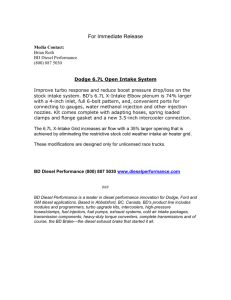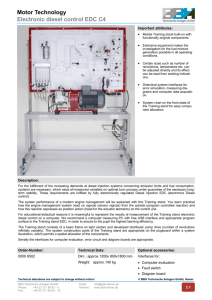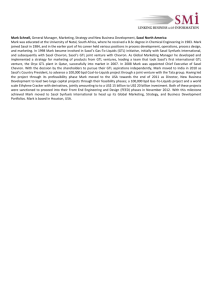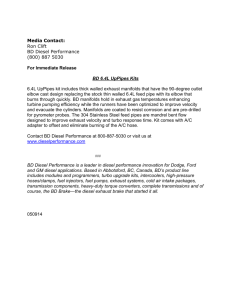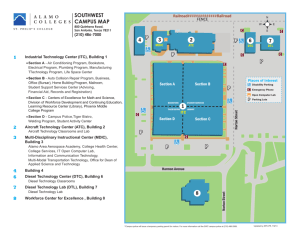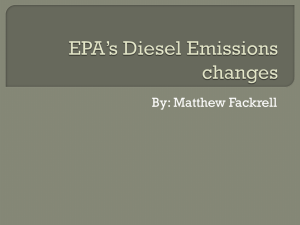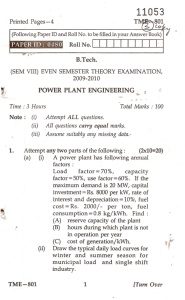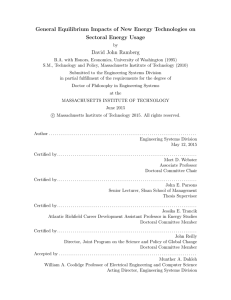SPE distinguished lecture
advertisement
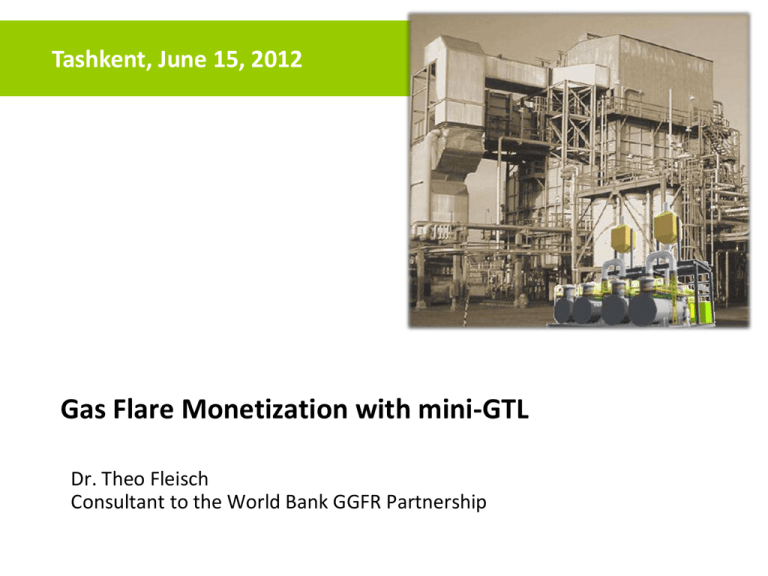
Tashkent, June 15, 2012 Gas Flare Monetization with mini-GTL •Dr. Theo Fleisch •Consultant to the World Bank GGFR Partnership GGFR Study with Final Report in February 2012 Study Lead: Martyn Howells Bent Svensson Study Research: Theo Fleisch Time: 1H 2011 Update in February 2012 Available to GGFR members Major Conclusions Large scale GTL technologies are proven and profitable (Shell, Sasol , Methanex, etc) A few “miniGTL” technologies are for the 1st time commercially available to reduce global gas flaring and monetize smaller gas volumes Most of these technologies are based on proven “syngas” routes and have been demonstrated in pilot plants Onshore and Offshore applications are possible Economic returns look attractive because of the high value products associated with high crude prices Why GTL? Monetize “stranded” gas (Trinidad, Qatar,…) Add value to gas (gas/oil arbitrage: $4/MMBTU to $20/MMBTU in US today) Valuable products − Clean drop-in fuels (gasoline, diesel) − Advanced fuels and chemicals (DME, methanol, etc) Energy security − Reduction of imported fuels (280MM m3 /d gas equates to 1MMbpd products) − Domestic production (investments, jobs) GTL: Gas to Liquids – Broad Product Options Gas to Liquids GTL-FT Step 1: Reforming Natural Gas Syngas Step 2: Fischer Tropsch Diesel Step 3: Upgrading Naphtha Lubes Gas to Chemicals (GTC) and Fuels Methanol CH4 CO and xH2 DME, Olefins, Gasoline Fuel Additives (MTBE, butanol, DMC, etc) Ammonia, Urea, Natural gas requirements Methane is the preferred feedstock (separate and sell condensates and NGL) However, C2+ (ethane and higher) can be accommodated with minor modifications if gas fractionation is not feasible Poisons such as sulfur and mercury must be removed Nitrogen and carbon dioxide are diluents and can be tolerated in moderate concentrations Pressure is an advantage since the 1st step reformers run at elevated pressures (>20bar) Gas feed rates as steady as possible for 10+ years SHELL BINTULU MALAYSIA SASOL ORYX QATAR METHANEX/BP ATLAS TRINIDAD SASOL SECUNDA SOUTH AFRICA Some historic GTL conversion plants Large scale GTL plants: economy of scale Plant Country Gas Feed Rate Product Production Shell Bintulu Malaysia 3.4mm m3/d Diesel+ 12,000bpd Mossgas South Africa 6.8mm m3 /d Diesel+ 24,000bpd Sasol Oryx Qatar 10mm m3/d Diesel+ 35,000bpd Shell Pearl Qatar 40mm m3/d Diesel+ 140,000bpd Titan Trinidad 2.1mm m3/d methanol 2500tpd Atlas Trinidad 4.2mm m3/d methanol 5000tpd Escravos Nigeria 2013 10mm m3/d Diesel+ 35,000bpd Sasol Karshi Uzbekneftegaz Uzbekistan (planned) 10.8mm m3/d Diesel+ 38,000bpd SasolTalisman Canada (planned) 14-28mm m3/d Diesel+ 50,000100,000bpd 23mm m3/d 80,000bpd Sasol Louisiana USA (planned) Diesel+ Challenges with flared gas for mini-GTL No economy of scale! − High capital costs with low financial returns Very remote locations and lack of infrastructure − Delivery of bulky equipment − Additional costs for utilities Gas production profiles (declining with time) − Original plant size becomes underutilized Local markets for products • Need for small scale, modular, low cost process units with flexible capacity and for readily useable products Companies developing mini-GTL technologies Evaluation of technologies Overall technical risks Status of technology development Laboratory, pilot plant and demonstration plant status Remaining hurdles Overall Commercial readiness (onshore and offshore) Size applicability Small: <1mmscfd (<28,000m3/d) Medium: 1 -10mmscfd (28,000 – 280,000m3/d) Large: >10mmscfd (>280,000m3/d) Overall Risk and Time to Commercialization HIGH OVERALL RISK METHION OBERON LOW SHORT TIME TO COMMERCIALIZATION LONG CompactGTL Technology: process intensified mini-channel reactor technology for both the reformer and the FT unit Product: diesel or waxy syncrude Successful 20bpd demonstration plant with Petrobras in Brazil Numerous commercial feasibility studies Velocys (Oxford Catalysts) Technology: Breakthrough micro-channel technology Reactor channels are <1mm diameter Catalyst coating inside Very compact modular design Reactor modules can be removed when gas production falls Velocys: status and path foward Commercial development is underway − 3 demonstration projects underway (<1MMscfd) in Brazil, Austria and the USA All GTL steps proven by 2012 (SMR, FT, Hydrocracking) Velocys is accepting commercial orders for FT units now (have already sold 4 FT reactors) Rosneft purchased a 100bpd unit for Angarsk refinery, Siberia, converting 10mm m3/y Multiple feasibility studies underway www.velocys.com GASTECHNO: Overview Relatively simple technology: − Direct oxidation of methane to methanol (no catalyst, no syngas) − Modular, skid mounted design Technology proven in 50kscfd (1400 m3/d) demo with good mass and energy balance By-products: formalin, ethanol Modules available for sale or lease (~/<30,000m3/d) Basic evaluation and engineering packages (28,000 to 850,000m3/d) www.gastechno.com OBERON FUELS: Overview TECHNOLOGY − Skid mounted DME − Modular design − Targets are small natural gas and/or biogas sources (<2MMscfd or <50,000m3/d) − Markets: local heavy duty diesel fleets converted to DME 1st plant to be built in CA in 2013 (feed is methanol) 2nd plant will demonstrate the whole chain from natural gas www.oberonfuels.com ECONOMICS BALLPARK ESTIMATOR Attractive economics: product/feedstock thermal value spread is >3 E.g. gas at $4/MMBTU and diesel at $20/MMBTU equals spread of 5 Plant size 10,000scfd (280m3/d) == 1bpd liquid product − 5MMscfd (140,000m3/d) == 500bpd Capex ~$80,000/daily barrel 5MMscfd (140,000m3/d) plant: ~$40MM +/-50% Annual revenue: ~$17MM (at $100/barrel and 350 days of operation) Minus Opex: ~$3MM Minus gas cost Oil-gas spread: past, present and future GTL economics works well at oilgas spreads at 3 and above Conclusions The GTC and GTL industries are global and well established A few “miniGTL” are now available to reduce global gas flaring and monetize smaller gas volumes Most of these technologies are based on proven syngas routes and have been demonstrated in pilot plants Offshore applications are possible Economics look attractive because of the high value products associated with high crude prices Numerous other technologies are under development and some might see commercialization within the next 5 years Recommendations Evaluate mini-GTL technologies as potential new options Time is right for commercial applications The World Bank GGFR is ready to assist you Martyn Howells: hhowells@worldbank.org Bakhtiyar Karimov: bkarimov@worldbank.org Theo Fleisch: theo.fleisch@gmail.com
